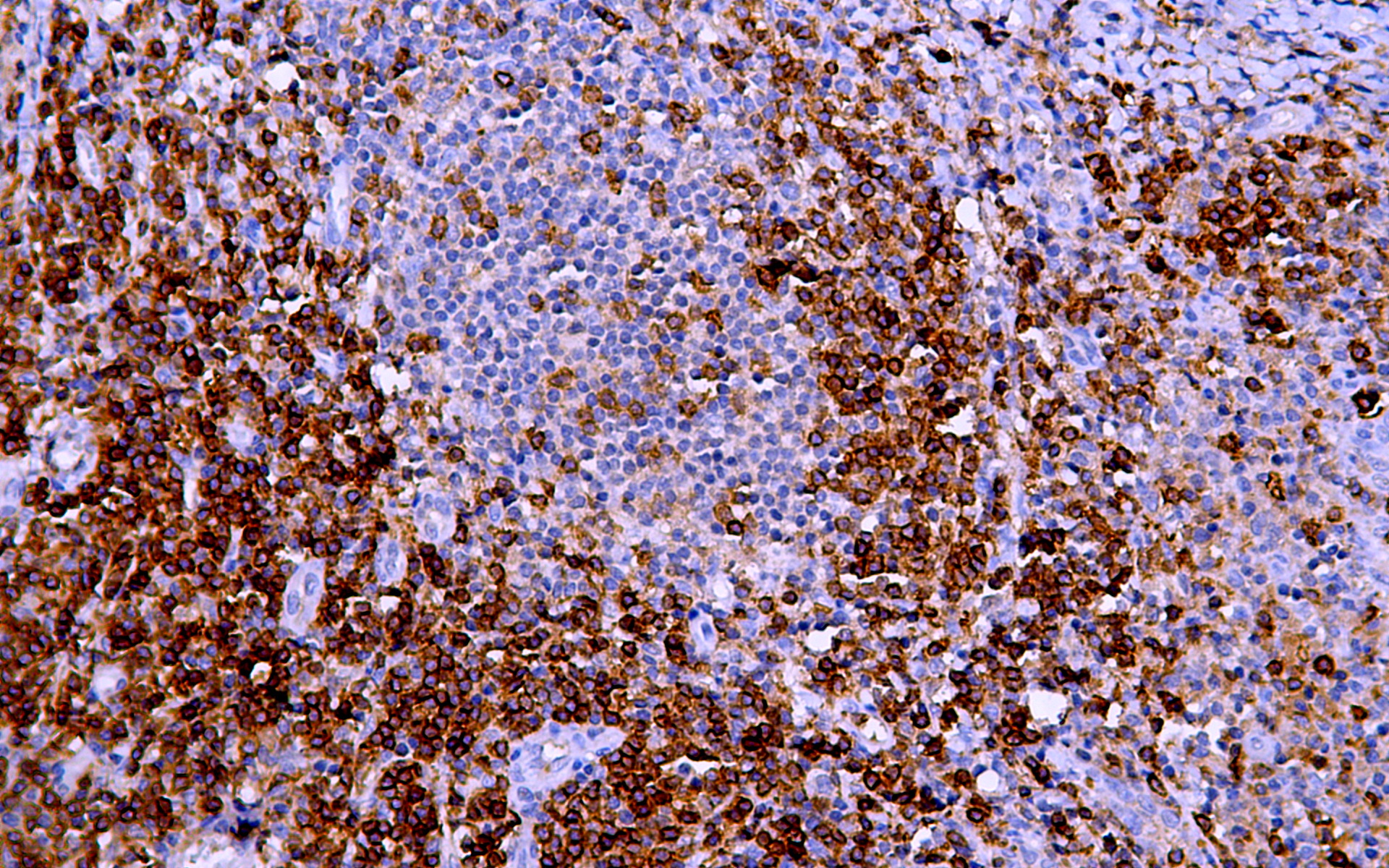CD7 Antibody
Mouse Monoclonal Antibody (Mab)
- SPECIFICATION
- CITATIONS
- PROTOCOLS
- BACKGROUND

Application
| IHC |
|---|---|
| Primary Accession | P09564 |
| Reactivity | Human |
| Host | Mouse |
| Clonality | Monoclonal |
| Isotype | IgG1 |
| Clone Names | 634A6D3 |
| Calculated MW | 25409 Da |
| Gene Name | CD7 |
|---|---|
| Other Names | T-cell antigen CD7, GP40, T-cell leukemia antigen, T-cell surface antigen Leu-9, TP41, CD7, CD7 |
| Dilution | IHC~~Ready-to-use |
| Storage | Maintain refrigerated at 2-8°C |
| Precautions | CD7 Antibody is for research use only and not for use in diagnostic or therapeutic procedures. |
| Name | CD7 |
|---|---|
| Function | Not yet known. |
| Cellular Location | Membrane; Single-pass type I membrane protein EMBL; X06180; CAA29546.1; -; mRNA EMBL; M37271; AAA51953.1; -; Genomic_DNA EMBL; BT006696; AAP35342.1; -; mRNA EMBL; BC009293; AAH09293.1; -; mRNA EMBL; BC013297; AAH13297.1; -; mRNA EMBL; D00749; BAA00646.1; -; Genomic_DNA CCDS; CCDS11807.1; - PIR; A39016; A39016 RefSeq; NP_006128.1; NM_006137.6 UniGene; Hs.36972; - ProteinModelPortal; P09564; - SMR; P09564; - BioGrid; 107362; 8 IntAct; P09564; 5 MINT; P09564; - STRING; 9606.ENSP00000312027; - iPTMnet; P09564; - PhosphoSitePlus; P09564; - SwissPalm; P09564; - BioMuta; CD7; - DMDM; 116031; - jPOST; P09564; - PaxDb; P09564; - PeptideAtlas; P09564; - PRIDE; P09564; - ProteomicsDB; 52247; - DNASU; 924; - Ensembl; ENST00000312648; ENSP00000312027; ENSG00000173762 GeneID; 924; - KEGG; hsa:924; - CTD; 924; - DisGeNET; 924; - EuPathDB; HostDB:ENSG00000173762.7; - GeneCards; CD7; - HGNC; HGNC:1695; CD7 HPA; CAB002594; - HPA; HPA039079; - MIM; 186820; gene neXtProt; NX_P09564; - OpenTargets; ENSG00000173762; - PharmGKB; PA26234; - eggNOG; ENOG410IYNZ; Eukaryota eggNOG; ENOG41117EQ; LUCA GeneTree; ENSGT00390000013965; - HOGENOM; HOG000285979; - HOVERGEN; HBG005290; - InParanoid; P09564; - KO; K06457; - OMA; YEDMSHS; - OrthoDB; 1083212at2759; - PhylomeDB; P09564; - TreeFam; TF338565; - SignaLink; P09564; - GeneWiki; CD7; - GenomeRNAi; 924; - PRO; PR:P09564; - Proteomes; UP000005640; Chromosome 17 Bgee; ENSG00000173762; Expressed in 114 organ(s), highest expression level in blood ExpressionAtlas; P09564; baseline and differential Genevisible; P09564; HS GO; GO:0016021; C:integral component of membrane; TAS:UniProtKB GO; GO:0016020; C:membrane; TAS:ProtInc GO; GO:0005886; C:plasma membrane; TAS:ProtInc GO; GO:0038023; F:signaling receptor activity; TAS:UniProtKB GO; GO:0002250; P:adaptive immune response; IEA:UniProtKB-KW GO; GO:0006955; P:immune response; TAS:UniProtKB GO; GO:0042110; P:T cell activation; TAS:UniProtKB GO; GO:0007169; P:transmembrane receptor protein tyrosine kinase signaling pathway; NAS:UniProtKB Gene3D; 2.60.40.10; -; 1 InterPro; IPR039090; CD7 InterPro; IPR007110; Ig-like_dom InterPro; IPR036179; Ig-like_dom_sf InterPro; IPR013783; Ig-like_fold InterPro; IPR003599; Ig_sub InterPro; IPR013106; Ig_V-set PANTHER; PTHR15343; PTHR15343; 1 Pfam; PF07686; V-set; 1 SMART; SM00409; IG; 1 SMART; SM00406; IGv; 1 SUPFAM; SSF48726; SSF48726; 1 PROSITE; PS50835; IG_LIKE; 1 1: Evidence at protein level; Adaptive immunity; Complete proteome; Disulfide bond; Glycoprotein; Immunity; Immunoglobulin domain; Lipoprotein; Membrane; Palmitate; Polymorphism; Receptor; Reference proteome; Repeat; Signal; Transmembrane; Transmembrane helix SIGNAL 1 25 CHAIN 26 240 T-cell antigen CD7 /FTId=PRO_0000014633 TOPO_DOM 26 180 Extracellular TRANSMEM 181 201 Helical. TOPO_DOM 202 240 Cytoplasmic DOMAIN 26 130 Ig-like REPEAT 145 153 1 REPEAT 154 162 2 REPEAT 163 171 3 REPEAT 172 180 4 REGION 145 180 4 X 9 AA tandem repeats, potential spacer function LIPID 198 198 S-palmitoyl cysteine CARBOHYD 45 45 N-linked (GlcNAc...) asparagine CARBOHYD 96 96 N-linked (GlcNAc...) asparagine DISULFID 35 142 {ECO:0000255|PROSITE-ProRule:PRU00114} DISULFID 48 114 {ECO:0000255|PROSITE-ProRule:PRU00114} VARIANT 113 113 T -> A (in dbSNP:rs34579511) /FTId=VAR_049855 SEQUENCE 240 AA; 25409 MW; EBBCE08279552108 CRC64; MAGPPRLLLL PLLLALARGL PGALAAQEVQ QSPHCTTVPV GASVNITCST SGGLRGIYLR QLGPQPQDII YYEDGVVPTT DRRFRGRIDF SGSQDNLTIT MHRLQLSDTG TYTCQAITEV NVYGSGTLVL VTEEQSQGWH RCSDAPPRAS ALPAPPTGSA LPDPQTASAL PDPPAASALP AALAVISFLL GLGLGVACVL ARTQIKKLCS WRDKNSAACV VYEDMSHSRC NTLSSPNQYQ |

Thousands of laboratories across the world have published research that depended on the performance of antibodies from Abcepta to advance their research. Check out links to articles that cite our products in major peer-reviewed journals, organized by research category.
info@abcepta.com, and receive a free "I Love Antibodies" mug.
Provided below are standard protocols that you may find useful for product applications.
If you have used an Abcepta product and would like to share how it has performed, please click on the "Submit Review" button and provide the requested information. Our staff will examine and post your review and contact you if needed.
If you have any additional inquiries please email technical services at tech@abcepta.com.













 Foundational characteristics of cancer include proliferation, angiogenesis, migration, evasion of apoptosis, and cellular immortality. Find key markers for these cellular processes and antibodies to detect them.
Foundational characteristics of cancer include proliferation, angiogenesis, migration, evasion of apoptosis, and cellular immortality. Find key markers for these cellular processes and antibodies to detect them. The SUMOplot™ Analysis Program predicts and scores sumoylation sites in your protein. SUMOylation is a post-translational modification involved in various cellular processes, such as nuclear-cytosolic transport, transcriptional regulation, apoptosis, protein stability, response to stress, and progression through the cell cycle.
The SUMOplot™ Analysis Program predicts and scores sumoylation sites in your protein. SUMOylation is a post-translational modification involved in various cellular processes, such as nuclear-cytosolic transport, transcriptional regulation, apoptosis, protein stability, response to stress, and progression through the cell cycle. The Autophagy Receptor Motif Plotter predicts and scores autophagy receptor binding sites in your protein. Identifying proteins connected to this pathway is critical to understanding the role of autophagy in physiological as well as pathological processes such as development, differentiation, neurodegenerative diseases, stress, infection, and cancer.
The Autophagy Receptor Motif Plotter predicts and scores autophagy receptor binding sites in your protein. Identifying proteins connected to this pathway is critical to understanding the role of autophagy in physiological as well as pathological processes such as development, differentiation, neurodegenerative diseases, stress, infection, and cancer.


